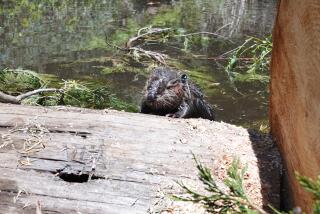Still busy and unperturbed
- Share via
MARTINEZ, CALIF. — Beavers that took up residence in a downtown creek here are staying put despite a noisy three-week construction project to shore up the bank near their lodge, relieved beaver supporters say.
The eight beavers that live in Alhambra Creek near the city center have been spotted entering and leaving their lodge at dusk, even though workers drove 25-foot-long metal sheet piles into the ground a few feet from their burrow.
“The beavers are fine,” said Linda Meza, a spokeswoman for the beaver support group Worth a Dam.
But a new controversy over the project has emerged since Worth a Dam uncovered a photograph in the Martinez Museum showing that damage attributed to the beavers dates to at least 1999 -- seven years before the animals arrived.
Meza said the photo proved what the group had been saying all along: The $400,000 construction project was unnecessary.
Worth a Dam has criticized the City Council for improperly meeting in private on the issue and for bypassing an environmental review by declaring the situation an emergency.
“The city was aware that the beavers were not burrowing under the retaining wall,” Meza said. “The premise for this emergency work was based on lies.”
Martinez, 35 miles northeast of San Francisco, was founded during the Gold Rush.
The city of 37,000 boasts that it was the home of conservationist John Muir, but it has also been the site of a huge oil refinery for nearly a century.
The first two beavers arrived in 2006, and since then they have been busy. They produced two kits, or baby beavers, last year and four more this year while building two lodges and four dams in the creek.
After word of the beavers’ presence spread, tourists began visiting Martinez to see them -- an unusual occurrence for the refinery town.
But the property owner nearest the beaver habitat complained that the rodents were causing damage by burrowing into the bank and under the retaining wall. He threatened to sue the city if it didn’t take action.
City officials at first planned to kill the beavers but backed off after many residents protested. The City Council then voted to shore up the bank along a one-block stretch by driving sheet piles between the creek and the retaining wall.
Beaver supporters opposed the project for fear the animals might be killed or driven off, but the large rodents have proved adaptable.
With the last of the sheet piles in place, workers poured concrete between the piles and the retaining wall last week and finished filling in with dirt this week.
Even so, the dispute continues. Last week, Worth a Dam uncovered the 1999 photograph of the creek taken when the water level was unusually low. The group says the photo clearly shows that a crack in the retaining wall was already evident.
Worth a Dam accuses the City Council of going ahead with the project to pacify an influential property owner even though it knew the beavers had not caused the problem.
“They met in secret, voted in secret, omitted in secret and lied in public,” wrote Worth a Dam President Heidi Perryman in a post on the group’s website. “They spent nearly half a million of your taxpayer dollars on a Faustian contract that had nothing to do with public safety.”
In an interview, City Manager Phil Vince defended the decision but declined to say whether the council was aware that damage to the retaining wall predated the beavers’ arrival.
“I don’t think it was a misguided project whatsoever,” he said.
“We have invested a ton of time and effort to make this happen, and I am not interested in revisiting history.”
Vince said that although some residents see protecting the beavers as a waste of money, he believes it is good for Martinez’s quality of life to have the animals living downtown. He hopes the city can develop a long-term plan to protect its wildlife.
“I’m glad the beavers have stayed,” he said. “Beavers on the whole are pretty resilient. They took it in stride.”
--
More to Read
Sign up for Essential California
The most important California stories and recommendations in your inbox every morning.
You may occasionally receive promotional content from the Los Angeles Times.










